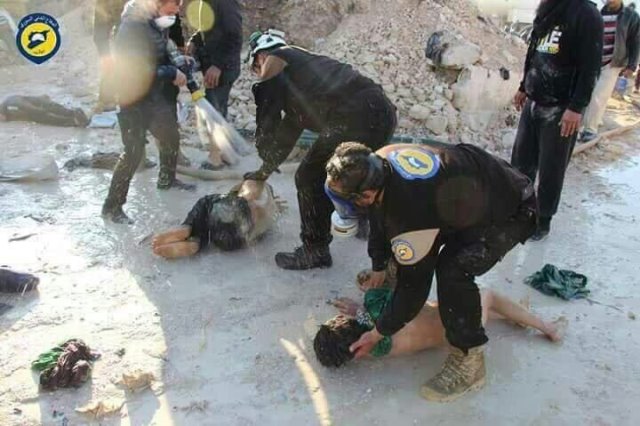US President Donald Trump faces perhaps his toughest foreign policy challenge yet amid calls for the United States to take a stand following a chemical attack on a rebel-held town in Syria that killed scores of civilians.
Trump said that Tuesday’s attack “crossed a lot of lines” for him and that his “attitude towards Syria and Assad has changed very much.” The US ambassador to the United Nations, Nikki Haley, meanwhile hinted at the US being “compelled to take our own action” over Syria, although she didn’t say what that might be.
Trump has not yet spelled out what his administration will do, if anything. But inevitably, speculation is focused on whether he might embark on military action where former US President Barack Obama did not.
So what are the possible military options for the US in Syria?
Strategic airstrikes
The US could seek to carry out punitive airstrikes against Syrian military assets or even its leadership, said Justin Bronk, a research fellow in the military sciences team at the UK-based RUSI think tank.
But a major obstacle lies in the way: Russian air defense systems within Syria which effectively give Moscow control of the airspace over much of Syria.
Russia has been building up its air defenses in Syria since intervening in support of Syrian President Bashar al-Assad in 2015, with bases in Hmeimim, Latakia and Tartus. It has moved advanced S-300 and S-400 missile defense systems into place and also has its own fighter jets to deploy.
Since it is highly unlikely that Russia would allow US strikes against its ally, the US would have to use stealth aircraft such as the F-22 or B-2 Spirit to try to evade detection by the Russian air defenses, said Bronk. That would be a very expensive option with a limited number of aircraft available.
If strikes went ahead, potential targets could include military depots, storage sites or Syrian air defenses, Bronk said.
A complicating factor is that Russian specialists could be embedded with Syrian forces, he said. The Trump administration would have to weigh whether it is willing to risk any Russian casualties, given the potential to escalate hostilities.
Russian Defense Ministry spokesman Igor Konashenkov warned in October against any strikes from the air against Syrian troops.
“Operators of Russian air defense systems won’t have time to identify the origin of airstrikes, and the response will be immediate,” he told reporters. “Any illusions about ‘invisible’ jets will inevitably be crushed by disappointing reality.”
“With the Russian military as a dominant power in Syria, the options for the United States are limited,” said Ambassador Nicholas Burns, former US Under Secretary for Political Affairs and now professor of international politics at the Harvard Kennedy School of Government.
“In 2013, I think President Obama should have used American air power against the Syrian Air Force. It would have taken away the ability to use chemical weapons against their population. That was an opportunity that was missed nearly three-and-a-half years ago.”
Daniel Serwer, director of the Conflict Management Program at Johns Hopkins University, said the US could explore a number of options.
These could include identifying and destroying the aircraft or artillery involved in launching the chemical weapons, or launching an air attack on the Syrian and allied ground forces advancing on opposition-controlled areas, he said.
“So far, Donald Trump has said this cannot be ignored by the civilized world, but has done nothing,” Serwer said, adding that “Trump’s failure to act is a green light for Assad to do as he likes.”
Cruise missiles
Another option is the launch of cruise missiles from US destroyers deployed in the Mediterranean.
Back in August 2013, Obama considered deploying cruise missiles against command and control targets in Syria, as well as chemical weapon launchers, US officials told CNN at the time. Shortly after, however, Syria agreed to a Russian proposal to relinquish its chemical weapons, leading Obama to retreat from threats of military action.
Two years earlier, US and allied forces had carried out missile strikes against Libyan air defense and other military targets in an intervention that aided Libyan rebels as they fought the forces of strongman leader Moammar Gadhafi.
Both Russia and the US have previously used cruise missiles to strike inside Syria, said Bronk, but they are less useful for hitting moving targets and carry a greater risk that they will go astray and kill civilians.
“Particularly with the recent collateral damage-heavy attacks that the US has conducted in Iraq and Syria, that’s already a very sensitive topic,” he said. “Whether the Trump administration particularly worries about that or wants to take a harder approach to how many civilian casualties are justified … is open to question.”
‘No-fly’ zone
There could be talk of the US imposing “no-fly” zones on the Syrian air forces, said Bronk, but this would again largely depend on whether the Russians want to play ball.
The Russian air forces in Syria fly a lot of the same aircraft as their Syrian counterparts, he said, which makes identifying who is in the air very difficult even with advanced radar.
“A no-fly zone would either mean the Russians in effect agreeing to constrain and turn on their own ally or the United States accepting that it’s basically unenforceable — unless they are willing to risk shooting down Russian aircraft, of course, which again seems unlikely.”
Safe zones
The US could go forward with a plan to declare and defend safe areas, said Serwer, of Johns Hopkins University.
US Secretary of State Rex Tillerson said last month that the administration backs the idea of creating “interim zones of stability” within Syria where refugees could go. But he didn’t offer any detail on a plan that would require defending those zones, and therefore heighten the risk of military clashes with Russia.
The Obama administration had hesitated to establish “safe zones” because of the military commitment required to defend such areas from Syrian government forces and the possibility of a run-in with Russian forces.
Safe zones also would not have a great punitive effect on Syria and would be expensive and difficult to enforce, said Bronk.
Tillerson is due to meet with his Russian counterpart, Sergey Lavrov, next week in Moscow for talks likely to be dominated by Syria.
Sen. Gary Peters, a Democrat on the Armed Services Committee, told CNN that it is “time to take a very strong stand against Assad” and that the Syrian President “simply cannot stay there.” After Assad is pushed out, through pressure from the international community, the provision of safe zones would give the Syrian people some security and stability, he said.
Ground forces
US Special Operations Forces, Marines and Army Rangers are on the ground in Syria, US officials told CNN last month. US forces are supporting local fighters as they prepare to launch an assault on Raqqa, the self-declared capital of ISIS in northern Syria.
However, it is “extremely unlikely” that there would be any kind of large scale US boots-on-the-ground operation as seen in Iraq in 2003, said Bronk, “because I think even the Trump administration would be able to see that that would lead to an endless quagmire, not to mention (the US) would be invading areas where Russian forces hold ground.”
He added, “Russia has sent a lot of signals on the military-to-military level that it really isn’t messing around in Syria.”
Republican Sen. Bob Corker, chairman of the Senate Foreign Relations Committee, told CNN that “obviously the United States doesn’t want to get sucked into some long ground war, but there are ways that we can send signals to Assad and I’m sure those plans are being developed.”




